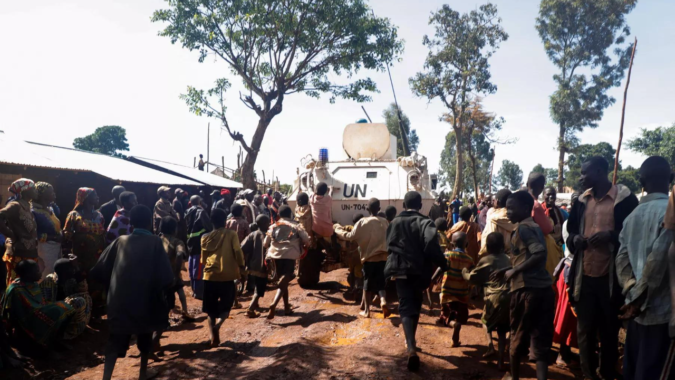DRODRO: One month since rebels closed in on Drodro village in eastern Congo, the once bustling wards of its hospital are empty, and Doctor James Semire strolls the darkened corridors wondering when patients will dare to return.
The community is one of many in Ituri province’s Djugu territory that has seen a surge in attacks by the Cooperative for the Development of the Congo armed group (CODECO), with around 550,000 people forced to flee their homes between January and March, according to UN data.
Semire said members of the Hema herding community started to abandon Drodro in mid-March ahead of a rumored advance by CODECO. The group, which claims to defend the interests of Lendu farmers, who have long conflicted with Hema herders, is one of the dozens of militias that have destabilized the eastern Democratic Republic of Congo since the 1990s.
Most Hema locals had left by March 22, when CODECO fighters took up positions on the hillside by Drodro in broad daylight, the doctor recalled on April 18.
“Suddenly, someone came to tell me that there were gunshots outside,” said Semire, who also fled his home but still works in the hospital in case any people come in needing treatment.
“There are repeated attacks – this delays the return of people here because it creates doubts,” he said.
The CODECO raids have worsened a longstanding humanitarian crisis in Ituri province, where some 3 million people are in desperate need of aid, according to the UN humanitarian agency.
Displaced shelter in the camp
Driven from their sources of livelihood, Ituri’s displaced people have gathered in areas of perceived safety such as Rhoe – a camp of ramshackle huts near a UN peacekeeping base north of Drodro. Its population has nearly doubled to 65,000 since the beginning of 2023, according to camp representative Samuel Kpadjanga.
Needs in the camp are acute. Some dwellings are little more than ragged lengths of canvas stretched over sticks. Meanwhile, many residents are traumatized, after losing their homes and possessions and suffering physical or sexual violence, said Grace Mugisalonga, a mental health expert at Rhoe for medical charity Medecins Sans Frontieres.
The road between Rhoe and the provincial capital Bunia, around 70 km (45 miles) to the southwest, is dotted with CODECO checkpoints, squeezing the camp’s supplies. The presence of fighters in the forests and fields around the camp makes attacks on those who venture out a regular occurrence, Kpadjanga said.
One resident, who asked not to be named, said a day earlier she had been held at gunpoint by three men in a nearby field.
“They argued. One said they should kill me, another said no. My life is safe, but they took everything from me, my scythe, my money,” she lamented back in a hut at Rhoe camp, as a toddler peeked at her from the doorway.
The community is one of many in Ituri province’s Djugu territory that has seen a surge in attacks by the Cooperative for the Development of the Congo armed group (CODECO), with around 550,000 people forced to flee their homes between January and March, according to UN data.
Semire said members of the Hema herding community started to abandon Drodro in mid-March ahead of a rumored advance by CODECO. The group, which claims to defend the interests of Lendu farmers, who have long conflicted with Hema herders, is one of the dozens of militias that have destabilized the eastern Democratic Republic of Congo since the 1990s.
Most Hema locals had left by March 22, when CODECO fighters took up positions on the hillside by Drodro in broad daylight, the doctor recalled on April 18.
“Suddenly, someone came to tell me that there were gunshots outside,” said Semire, who also fled his home but still works in the hospital in case any people come in needing treatment.
“There are repeated attacks – this delays the return of people here because it creates doubts,” he said.
The CODECO raids have worsened a longstanding humanitarian crisis in Ituri province, where some 3 million people are in desperate need of aid, according to the UN humanitarian agency.
Displaced shelter in the camp
Driven from their sources of livelihood, Ituri’s displaced people have gathered in areas of perceived safety such as Rhoe – a camp of ramshackle huts near a UN peacekeeping base north of Drodro. Its population has nearly doubled to 65,000 since the beginning of 2023, according to camp representative Samuel Kpadjanga.
Needs in the camp are acute. Some dwellings are little more than ragged lengths of canvas stretched over sticks. Meanwhile, many residents are traumatized, after losing their homes and possessions and suffering physical or sexual violence, said Grace Mugisalonga, a mental health expert at Rhoe for medical charity Medecins Sans Frontieres.
The road between Rhoe and the provincial capital Bunia, around 70 km (45 miles) to the southwest, is dotted with CODECO checkpoints, squeezing the camp’s supplies. The presence of fighters in the forests and fields around the camp makes attacks on those who venture out a regular occurrence, Kpadjanga said.
One resident, who asked not to be named, said a day earlier she had been held at gunpoint by three men in a nearby field.
“They argued. One said they should kill me, another said no. My life is safe, but they took everything from me, my scythe, my money,” she lamented back in a hut at Rhoe camp, as a toddler peeked at her from the doorway.
